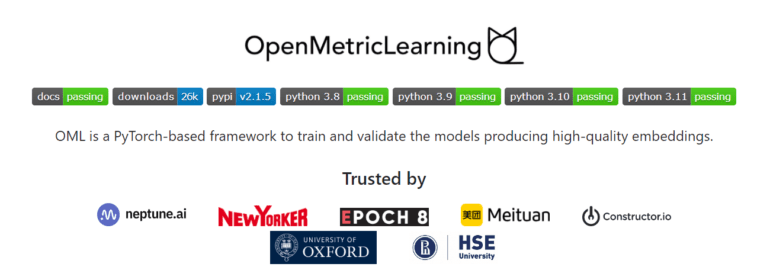TL;DR:
- OML, a PyTorch-based Python framework, tackles large-scale classification challenges with limited samples.
- It optimizes the distance between embeddings, ensuring classification accuracy aligns with retrieval metrics.
- OML’s end-to-end solution prioritizes practical use cases and includes user-friendly pipelines.
- It performs on par with state-of-the-art methods by efficiently using heuristics.
- OML integrates with self-supervised learning advancements, enhancing model initialization.
- Framework-agnostic design allows operation with both PyTorch Lightning and pure PyTorch.
- OML simplifies the experimental setup with extensive pre-trained models in its ‘Zoo.’
Main AI News:
In the realm of machine learning, the intricate challenge of efficiently addressing large-scale classification dilemmas, where a plethora of classes coexist, each with limited samples, looms large. This predicament is a recurring theme across diverse domains, encompassing facial recognition, individual and animal re-identification, landmark recognition, and the robust functioning of e-commerce platform search engines.
Enter the Open Metric Learning (OML) library, meticulously crafted using the PyTorch framework, to conquer this multifaceted conundrum. In stark contrast to conventional approaches that extract embeddings from rudimentary classifiers, OML takes a sophisticated route. In typical methodologies, the training regimen falls short of optimizing the distances between embeddings, leaving classification accuracy detached from retrieval metrics. Furthermore, the endeavor of crafting a metric learning pipeline from the ground up can be daunting, entailing complex facets like triplet loss, batch formation, and retrieval metrics, especially in a distributed data-parallel environment.
OML distinguishes itself by unveiling a comprehensive solution meticulously tailored for real-world applications. It places paramount importance on practical use cases, prioritizing scenarios such as the identification of products spanning diverse categories. This distinctive approach sets OML apart from other metric learning libraries that tend to be more tool-centric in nature. OML’s framework encompasses pipelines that streamline the model training process, akin to preparing data in a specific format for training object detectors. This feature imbues OML with a recipe-oriented character, endowing users with practical illustrations and pre-trained models ideally suited for common benchmarks.
In terms of performance, OML confidently strides alongside contemporary state-of-the-art methods. It accomplishes this feat by efficiently harnessing heuristics within its miner and sampler components, bypassing convoluted mathematical transformations while delivering outcomes of exceptional quality. This efficiency is unmistakably evident in benchmark evaluations, where OML thrives in handling large-scale classification quandaries with remarkable precision.
Another noteworthy facet of OML is its adaptability and harmonization with the latest strides in self-supervised learning. It capitalizes on these advancements for model initialization, establishing a robust foundation for subsequent training endeavors. Drawing inspiration from established methodologies, OML seamlessly incorporates concepts like memory banks into its TripletLoss, thereby augmenting its performance manifold.
Furthermore, OML’s architectural design is framework-agnostic. While it seamlessly integrates with PyTorch Lightning for experimental loops, it remains compatible with pure PyTorch, affording users the freedom to choose their preferred framework or enhance their familiarity with PyTorch Lightning. The modular architecture of OML’s codebase ensures this adaptability, ensuring that even Lightning-specific logic remains distinct from the core components.
The user-friendliness of OML extends to the experimental setup. Users are required to format their data in accordance with the library’s pipeline structure. To further streamline this process, OML boasts an extensive pre-trained model library, fondly known as the ‘Zoo.’ This invaluable resource often obviates the need for extensive training, as it provides readily available pre-trained models tailored to specific domains, thereby simplifying the user experience.
Conclusion:
OML’s innovative approach to deep learning and high-quality embeddings addresses the challenges of large-scale classification, ensuring that accuracy aligns with retrieval metrics. Its adaptability, efficiency, and user-friendly design position OML as a game-changer in the market, catering to a wide range of industries and applications. Its integration with self-supervised learning and framework-agnostic nature makes it a versatile choice for businesses seeking enhanced machine-learning solutions.

